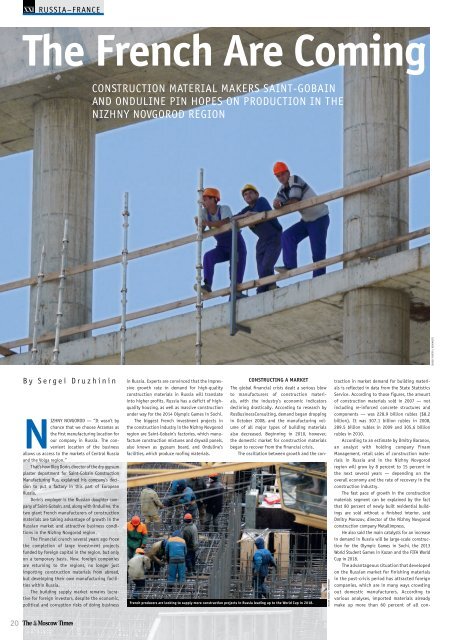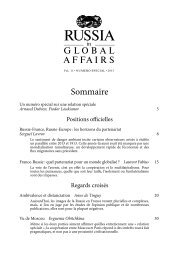said Oleg Dorin of Saint-Gobain. - CCIFR
said Oleg Dorin of Saint-Gobain. - CCIFR
said Oleg Dorin of Saint-Gobain. - CCIFR
- TAGS
- oleg
- dorin
- ccifr
- www.ccifr.ru
You also want an ePaper? Increase the reach of your titles
YUMPU automatically turns print PDFs into web optimized ePapers that Google loves.
20<br />
RUSSIA–FRANCE<br />
The French Are Coming<br />
By Sergei Druzhinin<br />
NIZHNY NOVGOROD — “It wasn’t by<br />
chance that we choose Arzamas as<br />
the first manufacturing location for<br />
our company in Russia. The convenient<br />
location <strong>of</strong> the business<br />
allows us access to the markets <strong>of</strong> Central Russia<br />
and the Volga region.”<br />
That’s how <strong>Oleg</strong> <strong>Dorin</strong>, director <strong>of</strong> the dry gypsum<br />
plaster department for <strong>Saint</strong>-<strong>Gobain</strong> Construction<br />
Manufacturing Rus, explained his company’s decision<br />
to put a factory in this part <strong>of</strong> European<br />
Russia.<br />
<strong>Dorin</strong>’s employer is the Russian daughter company<br />
<strong>of</strong> <strong>Saint</strong>-<strong>Gobain</strong>, and, along with Onduline, the<br />
two giant French manufacturers <strong>of</strong> construction<br />
materials are taking advantage <strong>of</strong> growth in the<br />
Russian market and attractive business conditions<br />
in the Nizhny Novgorod region.<br />
The financial crunch several years ago froze<br />
the completion <strong>of</strong> large investment projects<br />
funded by foreign capital in the region, but only<br />
on a temporary basis. Now, foreign companies<br />
are returning to the regions, no longer just<br />
importing construction materials from abroad,<br />
but developing their own manufacturing facilities<br />
within Russia.<br />
The building supply market remains lucrative<br />
for foreign investors, despite the economic,<br />
political and corruption risks <strong>of</strong> doing business<br />
CONSTRUCTION MATERIAL MAKERS SAINT-GOBAIN<br />
AND ONDULINE PIN HOPES ON PRODUCTION IN THE<br />
NIZHNY NOVGOROD REGION<br />
in Russia. Experts are convinced that the impressive<br />
growth rate in demand for high-quality<br />
construction materials in Russia will translate<br />
into higher pr<strong>of</strong>its. Russia has a deficit <strong>of</strong> highquality<br />
housing, as well as massive construction<br />
under way for the 2014 Olympic Games in Sochi.<br />
The biggest French investment projects in<br />
the construction industry in the Nizhny Novgorod<br />
region are <strong>Saint</strong>-<strong>Gobain</strong>’s factories, which manufacture<br />
construction mixtures and drywall panels,<br />
also known as gypsum board, and Onduline’s<br />
facilities, which produce ro<strong>of</strong>ing materials.<br />
CONSTRUCTING A MARKET<br />
The global financial crisis dealt a serious blow<br />
to manufacturers <strong>of</strong> construction materials,<br />
with the industry’s economic indicators<br />
declining drastically. According to research by<br />
RosBusinessConsulting, demand began dropping<br />
in October 2008, and the manufacturing volume<br />
<strong>of</strong> all major types <strong>of</strong> building materials<br />
also decreased. Beginning in 2010, however,<br />
the domestic market for construction materials<br />
began to recover from the financial crisis.<br />
The oscillation between growth and the con-<br />
French producers are looking to supply more construction projects in Russia leading up to the World Cup in 2018.<br />
MAXIM STULOV / VEDOMOSTI<br />
traction in market demand for building materials<br />
is reflected in data from the State Statistics<br />
Service. According to those figures, the amount<br />
<strong>of</strong> construction materials sold in 2007 — not<br />
including re-inforced concrete structures and<br />
components — was 228.9 billion rubles ($8.2<br />
billion). It was 307.1 billion rubles in 2008,<br />
289.5 billion rubles in 2009 and 305.6 billion<br />
rubles in 2010.<br />
According to an estimate by Dmitry Baranov,<br />
an analyst with holding company Finam<br />
Management, retail sales <strong>of</strong> construction materials<br />
in Russia and in the Nizhny Novgorod<br />
region will grow by 8 percent to 15 percent in<br />
the next several years — depending on the<br />
overall economy and the rate <strong>of</strong> recovery in the<br />
construction industry.<br />
The fast pace <strong>of</strong> growth in the construction<br />
materials segment can be explained by the fact<br />
that 80 percent <strong>of</strong> newly built residential buildings<br />
are sold without a finished interior, <strong>said</strong><br />
Dmitry Morozov, director <strong>of</strong> the Nizhny Novgorod<br />
construction company Metallimpress.<br />
He also <strong>said</strong> the main catalysts for an increase<br />
in demand in Russia will be large-scale construction<br />
for the Olympic Games in Sochi, the 2013<br />
World Student Games in Kazan and the FIFA World<br />
Cup in 2018.<br />
The advantageous situation that developed<br />
on the Russian market for finishing materials<br />
in the post-crisis period has attracted foreign<br />
companies, which are in many ways crowding<br />
out domestic manufacturers. According to<br />
various analyses, imported materials already<br />
make up more than 60 percent <strong>of</strong> all con-<br />
SERGEY PORTER / VEDOMOSTI




